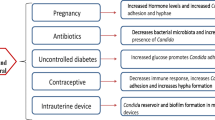Abstract
Vulvovaginal candidiasis (VVC) is a cause of significant morbidity in many women of a childbearing age worldwide.
There is a paucity of literature on the prevalence of this condition in post-menopausal women, although it is believed to be uncommon because of the estrogen dependence of VVC. Postmenopausal women who have underlying risk factors for VVC (e.g. hormone replacement therapy, uncontrolled diabetes mel-litus, immunosuppression caused by medication or disease) may be at risk of chronic or recurrent VVC. However, as in younger women, it is likely that, even after exhaustive investigations, no cause will be found in a significant number of patients.
The investigation and treatment of VVC in older women should be the same as that undertaken in younger women. Both topical and oral preparations are available, but oral regimens are perhaps more acceptable because of the ease of administration and avoidance of potentially messy creams and suppositories. Ketoconazole at a dosage of 400mg daily for 14 days can be used to achieve clinical remission of symptoms and negative fungal cultures. Induction treatment should be followed by maintenance therapy for 6 months with ketoconazole 100mg daily, itraconazole 50 to 100mg daily or fluconazole 100mg weekly or 150mg monthly.
Short courses of topical therapy, e.g. 500mg clotrimazole pessaries as a single weekly dose for 6 months or 100mg miconazole pessaries twice weekly for 3 months, followed by once weekly for 3 months may also be used.
Similar content being viewed by others
References
Hurley R, DeLouvis J. Candida vaginitis. Postgrad Med J 1979 Sep; 55(9): 645–7
Sobel JD. Vaginal infections in adult women. Med Clin North Am 1990 Nov; 74(6): 1573–602
Sobel JD, Chaim W, Leaman D. Recurrent vulvovaginal candidiasis associated with long-term tamoxifen treatment in postmenopausal women. Obstet Gynecol 1996 Oct; 88(4): 704–6
Peters NC. Vulvovaginitis in the postmenopausal woman. Nurs Pract Forum 1992 Sep; 3(3): 152–4
Sobel JD. Epidemiology and pathogenesis of recurrent vulvovaginal candidiasis. Am J Obstet Gynecol 1985 Aug; 152(7): 924–35
Sobel JD. Pathogenesis and treatment of recurrent vulvovaginal candidiasis. Clin Infect Dis 1992; 14Suppl. 1: S148–53
Trumbore DJ, Sobel JD. Recurrent vulvovaginal candidiasis: vaginal epithelial cell susceptibility to Candida albicans adherence. Obstet Gynecol 1986 Jun; 67(6): 810–4
Kinghorn GR. Vulvovaginal candidosis. J Antimicrob Chemother 1991; 28Suppl. A: 59–66
Waggoner S. Vulva and vagina. In: Hajj SN, Evans WT, editors. Clinical postreproductive gynecology. Norwalk (CT): Appleton and Lange, 1993: 317–21
Milsom I, Arvidsson L, Ekelund P, et al. Factors influencing vaginal cytology, pH and bacterial flora in elderly women. Acta Obstet Gynecol Scand 1993 Jun; 72(6): 286–91
Sobel JD. Vulvovaginal candidiasis: what we do and do not know. Ann Int Med 1984 Sep; 101(3): 390–2
Rodgers CA, Beardall AJ. Recurrent vulvovaginal cadidiasis: why does it occur? Int JSTD AIDS 1999 Jul; 10(7): 435–41
Schmid J, Rotman M, Reed B, et al. Genetic similarity of Candida albicans strains from vaginitis patients and their partners. J Clin Microbiol 1993 Jan; 31(1): 39–46
Vazquez JA, Sobel JD, Demetriou R, et al. Karyotyping of Candida albicans isolates obtained longitudinally in women with recurrent vulvovaginal candidiasis. J Infect Dis 1994 Dec; 170: 1566–9
Odds FC, Webster CE, Fisk PG, et al. Candida species and C. albicans biotypes in women attending clinics in genitourinary medicine. J Med Microbiol 1989 May; 29(1): 51–4
Sobel JD. Pathogenesis and epidemiology of vulvovaginal candidiasis. Ann N Y Acad Sci 1988; 544: 547–57
Odds FC. Candidosis of the genitalia. In: Odds FC, editor. Candida and candidosis. 2nd ed. London: Bailliere Tindall, 1988: 124–35
Anonymous. Vulvovaginitis. Am Coll Obstet Gynecol (ACOG) Tech Bull 1989; 135
Balsdon MJ, Tobin JM. Recurrent vaginal candidosis: a prospective study of effectiveness of maintenance miconazole treatment. Genitourin Med 1988; 64: 124–7
Sobel JD. Recurrent vulvovaginal candidiasis: a prospective study of the efficacy of maintenance ketoconazole therapy. N Engl J Med 1986; 315: 1455–8
Sobel JD. Management of recurrent vulvovaginal candidiasis with intermittent ketoconazole prophylaxis. Obstet Gynecol 1985; 65: 435–40
Sobel J, Faro S, Force RW, et al. Vulvovaginal candidiasis: epidemologic, diagnostic and therapeutic considerations. Am J Obstet Gynecol 1998 Feb; 178(2): 203–11
British National Formulary No. 38. London: The Pharmaceutical Press, 1999
Author information
Authors and Affiliations
Corresponding author
Rights and permissions
About this article
Cite this article
Nwokolo, N.C., Boag, F.C. Chronic Vaginal Candidiasis. Drugs & Aging 16, 335–339 (2000). https://doi.org/10.2165/00002512-200016050-00003
Published:
Issue Date:
DOI: https://doi.org/10.2165/00002512-200016050-00003



